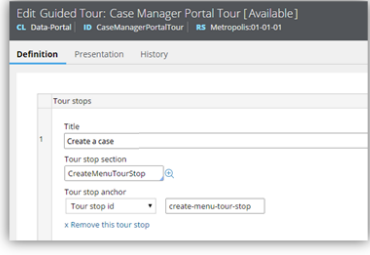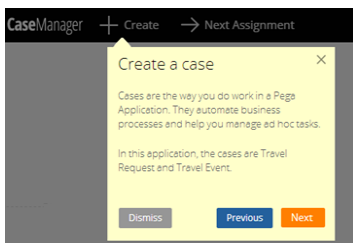Support for native search in custom mobile apps
Valid from Pega Version 8.1
To improve the overall user experience in a custom mobile app, you can configure native search in the user interface of the application. To use the search capability, first configure the pySearchConfiguration rule. This rule allows you to optionally define a set of search categories as a local data source. You then configure the mobile search action for any user interface control, for example, a button in a section. Users can tap the search field to see the most recent search results, including results that are grouped by categories, as they enter search text.
For more information, see Native search capability in custom mobile apps and Configuring search in custom mobile apps.
External login with OpenID Connect or SAML protocol for custom mobile apps
Valid from Pega Version 8.1
Custom mobile apps can now use single sign-on (SSO) with OpenID Connect or SAML to authenticate by using identity providers such as Google, Auth0, Okta, or Azure Active Directory (Azure AD). External login provides a convenient and secure way to access your application. Users' credentials are never shared with the custom mobile app.
For more information, see Configuring a custom mobile app to use external login with OpenID Connect or SAML protocol.
Build contextual help for user interfaces with guided tour rules
Valid from Pega Version 7.1.7
The guided tour rule is now available, enabling you to showcase the key features on user forms or portals by providing users with information, instructions, or controls in a sequence of pop-up windows called tour stops. The rule allows you to configure the sequence, format, and location in which they are displayed. The content of each tour stop is defined in a referenced section.

Guided tour rule form
This is what the users see when they click a control that links to the guided tour rule.

Guided tour pop-up
Responsive UI works with the Mobile Mashup SDK
Valid from Pega Version 7.1.7
Responsive UI elements now work inside of a mobile application that has been integrated with the Mobile Mashup SDK for either an iOS or Android mobile device. Using a responsive UI with your mobile application reduces development costs, since one UI functions in a similar manner when accessed from both desktop and mobile devices, making it easier to deploy an application across multiple device types.
See Mobile Mashup SDK integration for iOS and Mobile Mashup SDK integration for Android for more information on using the Mobile Mashup SDK.
Support for REST connectors to route network traffic via proxy
Valid from Pega Version 8.6
To easily route network traffic, you can now configure proxy details for individual REST connectors. This enhancement allows you to manage your proxy settings so that you can securely access online resources that lie beyond your proxy servers.
For more information, see Configuring a REST connector.
Supported artifacts section removed from repository rule form
Valid from Pega Version 8.1
The Supported artifacts check box has been removed from the repository rule form. Developers can use repositories to provide centralized storage, versioning, and metadata support for application artifacts.
For information about repository connections, see Creating a repository for file storage and knowledge management.
Data pages can source information from a robotic desktop automation
Valid from Pega Version 8.1
You can now configure data pages to source information from robotic desktop automations (RDA). Using an RDA to source a data page allows you to connect your Pega Platform™ application to any application that is accessible from an end-user's desktop. By using automations to retrieve data and load it into a data page, you can use data virtualization to separate your Pega Platform data model from the physical interface of a legacy system against which the automation is running.
For more information, see Obtaining information from robotic automations.
Support for multiple custom mobile apps for a Pega Platform application
Valid from Pega Version 8.1
To enhance the user experience and provide support for native mobile components, you can create multiple custom mobile apps for a Pega Platform™ application. For each custom mobile app, you must create a different mobile channel interface. In addition, you can configure each custom mobile app to run only in a specific portal for an application. The custom mobile app uses this portal regardless of which default portal is defined for the access group.
For more information, see Selecting a portal for a custom mobile app.
Data APIs support data exploration in React UI tables
Valid from Pega Version 8.5
Data APIs have been enhanced to support filtering, sorting, paging, and aggregation in React UI tables. You can use that functionality to access your data quickly and intuitively. For example, by using paging, you can query a data page to retrieve the second page of an employee contact list and specify the number of results that are displayed on the page.
For more information, see Data API performance and limitations.
Enhancements to token lifetime limits
Valid from Pega Version 8.5
Pega Platform™ uses OAuth 2.0 authorization codes, access tokens, and refresh tokens to provide flexible token-based security for applications. Expiration settings for these codes and tokens now adhere to certain strict value range based on industry leading practices. For example, the lifetime specified for the authorization code must be in the range 1-600 seconds.
These can be configured in the OAuth2 Client registration rule form.
For more information, see OAuth 2.0 Management Services.

